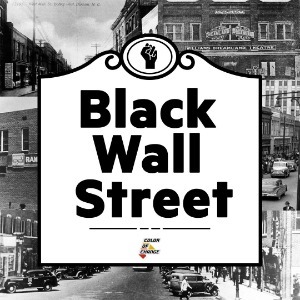|
As HBO’s series, The Watchmen reminds us, harm was done to the folks of Tulsa, Oklahoma. Angry at the economic success of Black people, on June 1, 1921, white residents of Tulsa attacked the all-Black, Greenwood neighborhood known as Black Wall Street. After looting Greenwood, attackers used dynamite and planes to bomb the city, leaving more than 8,000 people homeless.1 The white power structure did nothing to stop the massacre, as the intent was to let successful Black businesses and wealth burn. Tulsa’s Black Wall Street wasn’t the only city crushed by white terrorist violence - be it destruction, assault, or the orchestrated erosion of Black communities. With few safe spaces for Black banking and business, Black people created safe havens to meet economic and financial needs.
That’s why this Black History Month, we’re lifting up our Black Wall Streets and calling for a combined $300 billion reparative investment to help reinvigorate the spirit of the pinnacles of Black success. Like Tulsa’s Greenwood neighborhood, themes of entrepreneurship, ingenuity, and fullness resounded with Blackness. Nearly all of the Black Wall Streets had banks, businesses, and residential homes. Most declined around the Great Depression, but the cities themselves still exist. While there aren’t many records of each Black Wall Street’s total asset holdings, one estimation indexed to today’s inflation gives a value of around $195,000,000,2 totaling an equivalent value of $300 billion. Join us in demanding economic redress for the once vibrant Wall Streets of Black America.
The municipal banks receiving the investments would house no-repayment business investment initiatives for Black businesses, zero percent interest loans, and equity funding for neighborhood stabilization efforts. $300 billion is the equivalent value of cited Black Wall Street holdings during their peak economic boom. Our Black Wall Streets are directly impacted by decisions made at the municipal level; therefore it would be their responsibility to ensure these neighborhoods remain a part of the local fabric. These are the Black Wall Streets we’re calling on local municipalities to restore:
- Durham, NC: The all-Black neighborhood of Hayati (named after the country Haiti)3grew to house the North Carolina Mutual Life Insurance Co., the richest Black-owned company during the early 1900’s, which still has assets of over $200 million,4 as well as the first liberal arts HBCU to be state-funded in 1925 - North Carolina Central University.5
- Columbia, SC: For nearly a century, Columbia’s Black Wall Street was home to hundreds of thriving Black businesses, grocery stores, funeral homes, theatres, and two Black medical facilities. The last remnants were demolished to make way for an area currently known as Assembly and Gadsden Streets in downtown Columbia.6
- Richmond, VA: Home to Black-owned banks, insurance companies and other investment groups, the all-Black community of Jackson Ward was originally called the “birthplace of Black capitalism,” leading Richmond into the epicenter of Black finance.7
- Birmingham, AL: The area known as “Little Harlem” boasted retail shops, attorneys, banks, insurance companies, doctor’s offices, and half a dozen hotels.8 The buildings were designed by Black architects and built by Black construction companies, including the six-story structure built by the Black-owned Penny Savings Bank.9
- Boley, OK: Boley’s Black Wall Street boasted two colleges, a newspaper, its own water system, five grocery stores, five hotels, seven restaurants, four cotton gins, three drugstores, a jewelry store, four department stores, two insurance companies, two photographers, an ice plant, and a Black-owned electrical plant.10 Today, Boley hosts the largest and most popular Black rodeos in the country every year.11
- Mound Bayou, MS: An all-Black town in the delta of Mississippi, Mound Bayou had a post office, churches, banks, schools and stores. Despite its sharp population decline throughout the century, Mound Bayou still exists and has a 98.6 percent total black population.12
After the 1930s, despite their resilience, Black communities couldn’t keep up with urban renewal efforts. With inflated and unaffordable land, housing, and the number of Black-owned banks at their lowest number for the first time in history,13 the trail of ever-widening disparities can be traced to orchestrated attacks on Black Wall Streets. This trail will serve as the foundation for just repair. Join us in demanding reparations for our Black Wall Streets.
Until justice is real,
--Brandi, Rashad, Arisha, Jade, Johnny, Amanda, Evan, Eesha, Samantha, FolaSade, Marcus and the rest of the Color Of Change team
_________________________________________________________________________________________________________
References:
- “A Long-Lost Manuscript Contains a Searing Eyewitness Account of the Tulsa Race Massacre of 1921,” Smithsonian Magazine, May 27, 2016, https://act.colorofchange.org/go/236394?t=7&akid=41154%2E4731121%2EU0YBGk.
- “How the Other Half Banks.” Mehrsa Baradaran. October 6, 2015.
- “Hayti: The Heart of Durham’s Black Wall Street.” BlackThen. December 31, 2017. https://act.colorofchange.org/go/236395?t=9&akid=41154%2E4731121%2EU0YBGk
- “Hayti: The Heart of Durham’s Black Wall Street.” BlackThen. December 31, 2017. https://act.colorofchange.org/go/236395?t=11&akid=41154%2E4731121%2EU0YBGk
- “Hayti: The Heart of Durham’s Black Wall Street.” BlackThen. December 31, 2017. https://act.colorofchange.org/go/236395?t=13&akid=41154%2E4731121%2EU0YBGk
- “Remembering Columbia’s Black Wall Street.” Carolina Panorama. August 24, 2017. https://act.colorofchange.org/go/236454?t=15&akid=41154%2E4731121%2EU0YBGk
- “The Rise and Fall of Black Wall Street.” The Atlantic. August 31, 2016. https://act.colorofchange.org/go/236396?t=17&akid=41154%2E4731121%2EU0YBGk
- “The Rise and Fall of Black Wall Street.” The Atlantic. August 31, 2016. https://act.colorofchange.org/go/236396?t=19&akid=41154%2E4731121%2EU0YBGk
- “Fourth Avenue Business District, Booming Under Segregation.” AL.com. Updated January 14, 2019.https://act.colorofchange.org/go/236397?t=21&akid=41154%2E4731121%2EU0YBGk
- Fourth Avenue Business District, Booming Under Segregation.” AL.com. Updated January 14, 2019.https://act.colorofchange.org/go/236397?t=23&akid=41154%2E4731121%2EU0YBGk
- “Little Known Black History Facts: Boley, Oklahoma.” BlackAmericaWeb.com. No Date cited. https://act.colorofchange.org/go/236398?t=25&akid=41154%2E4731121%2EU0YBGk
- “Little Known Black History Facts: Boley, Oklahoma.” BlackAmericaWeb.com. No Date cited. https://act.colorofchange.org/go/236398?t=27&akid=41154%2E4731121%2EU0YBGk
- “Mound Bayou.” BlackPast. January 18, 2007. https://act.colorofchange.org/go/236399?t=29&akid=41154%2E4731121%2EU0YBGk
- “Minority-owned banks disappearing.” Avios. November 21, 2019.https://act.colorofchange.org/go/223280?t=31&akid=41154%2E4731121%2EU0YBGk

Color Of Change is building a movement to elevate the voices of Black folks and our allies, and win real social and political change. Help keep our movement strong.
If you're absolutely sure you don't want to hear from Color Of Change again, click here to unsubscribe.